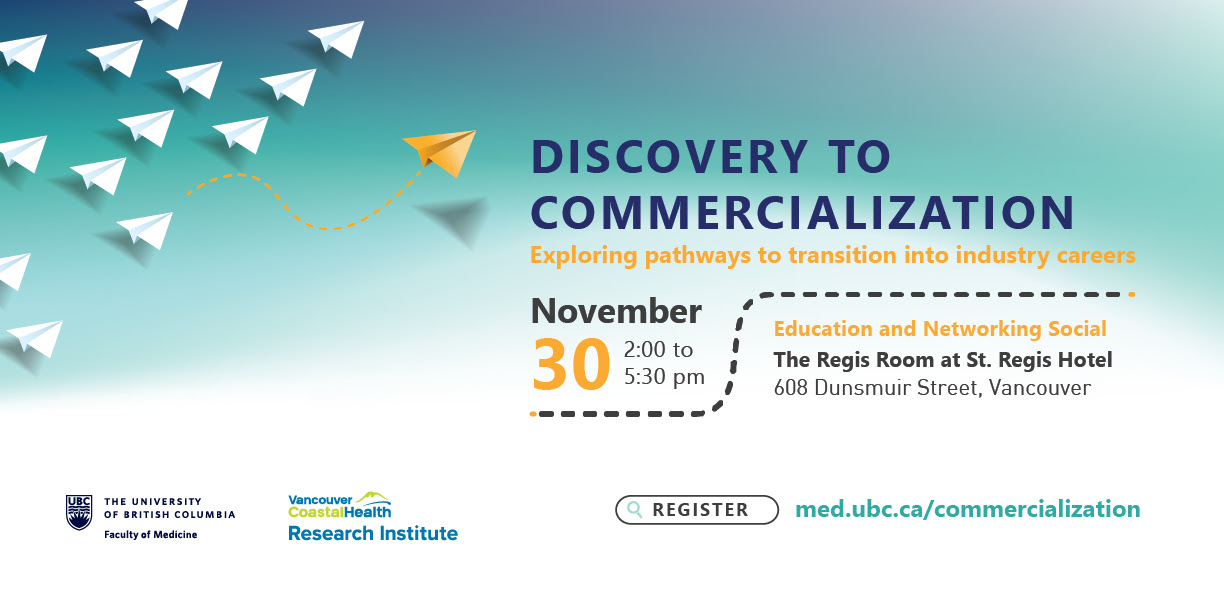

We had a really busy summer at ICORD. So busy, in fact, that we didn’t manage to publish the Summer issue of our newsletter while it was still summer. We are now very happy to present our first Early Fall issue in its place. In this issue, we’ll tell you about new machines that are helping ICORD researchers do their work, and hear from a very successful trainee who just earned her PhD, as well as catching up with a summer student, meeting our new study liaison, and more, including all our regular features. Special thanks to ICORD Social Media and Knowledge Translation assistant Jocelyn Chan, who wrote all the feature stories in this issue!
We hope you enjoy these stories:
- ICORD engineers get new research machines
- Advice from an award-winning grad student
- Thanks to the Aaron Moser Foundation
- Interviews with two Indigenous summer research students
- Dr. Mike Berger launches a new collaboration
- ICORD’s 2021-22 annual report is now available
- meetICORD event recap
- Meet our new Study Liaison!
And these regular features:
- A summary of summaries!
- What’s new at ICORD-O
- Art under the microscope
- Help us do research
- Partner news
OIBG: rise of the machines
ICORD’s Orthopaedic and Injury Biomechanics Group (OIBG) has recently taken possession of two new and very cool pieces of equipment that will help researchers study impact and collision biomechanics and allow a better understanding of how to best prevent injuries. Meet the Materials Testing System (MTS), and the KUKA 500 Robot.

MTS are used for a wide range of mechanical testing and besides research uses, they are often used for product design and manufacturing. For example, an MTS might be used to test whether a structure can handle a certain amount of compression force. Unlike other similar testing systems, the OIBG’s new MTS is ultra-fast (it’s the only MTS in Canada capable of achieving speeds up to 5 metres per second). The ability to mimic speeds of injuries that happen in the real world will allow for better understanding of spinal fracture and SCI mechanisms. “This new testing machine is pretty amazing because it’s capable of very high speeds. In terms of speed, there are only a few machines in the world that can go as fast as this one can,” said Dr. Peter Cripton, co-director of the lab.
After the MTS is fully commissioned, the lab plans to test some cadaveric cervical spine specimens under high-speed impacts, mimicking the type of impact that happens in a motorcycle crash where the rider is thrown off their motorcycle. The machine can also be used to examine other types of injuries. For example, pelvic injuries in motorcycle crashes that occur when the motorcyclist hits a car, moves forward. and their pelvis hits the gas tank. “We think there’s ways to prevent those injuries but nobody has really studied the human pelvis under these loading modes yet,” explained Dr. Cripton.
The OIBG has also purchased a KUKA 500, which is a large industrial robot. The KUKA 500, currently being housed off-site, has been programmed to recreate the motions of an automobile in a rollover, because people are more likely to break their necks in rollovers than other automotive crashes. “During a rollover, people dive into the roof and get a headfirst impact like somebody diving into the pool. We think there’s a way to install a vehicle safety device that would prevent those injuries, but we need to know more how neck muscles are activated and how neck posture is changed in a rollover,” said Dr. Cripton.

To test this hypothesis, human research participants are seated in the KUKA 500 and the seat is subjected to the same accelerations that it would undergo in a rollover (see photo above). An X-ray machine rides on the seat too, and takes a video of the participant’s neck during the phase during which they are preparing for impacts. Electrodes also record neck muscle activation. “Between that activation and the posture of the neck, we have a complete picture of the mechanical environment of the neck at the time just before the impact. It’s not the impact we care about but the time before the impact. We want to put a device in the car that would put the neck in a less vulnerable position to prevent injury, so we need to know about the starting position of a person’s neck,” he explained.
Funding for both machines was provided by the Canada Foundation for Innovation.

Advice from a star
One of ICORD’s most successful graduate students has just defended her PhD thesis and has some good advice for anyone wanting to follow in her footsteps.
Dr. Amanda Cheung started her Neuroscience PhD in September 2017 in the laboratory of Dr. Brian Kwon. Later, she also joined the lab of Dr. Babak Shadgan and was jointly-supervised by both ICORD PIs. During her time as an ICORD trainee, Amanda received many prestigious graduate scholarships and awards, including the Vanier Canada Graduate Scholarship, Killam Doctoral Scholarship, and VCHRI Top Graduating Doctoral Student Award. She also presented her research at more than 30 conferences and symposia.
Amanda’s thesis focused on developing and evaluating an implantable sensor to monitor the injured spinal cord; the sensor uses near-infrared spectroscopy (NIRS) with the goal of assessing changes in spinal cord oxygenation and hemodynamics in real-time after spinal cord injury.
Amanda credits her success with award applications to both her research project and extracurricular activities. “I was fortunate to work on an exciting and impactful research project, but I think leadership positions with student groups and councils at university and involvement in the community also helped strengthen my applications,” she explained.
It wasn’t all success, though. She also dealt with several failures. “For example, with the same Vanier and Killam award applications, I did not receive the CIHR Doctoral Award, and they all come from the same funding agency. So for people applying for awards, keep in mind that these awards can be very reviewer-dependent and don’t feel discouraged if it doesn’t work out. A mix of good timing and luck is inherently part of the process as well,” she said.
Amanda had the unique PhD experience of being co-supervised by Drs. Kwon and Shadgan. “They are both incredible mentors, and I’m deeply grateful for their guidance and leadership. I learned several valuable lessons that applied to my work and beyond such as looking at the bigger picture, not limiting myself (they encouraged and believed that I could accomplish more than I thought was possible), and how to effectively communicate through writing, presenting, etc.,” said Amanda. Teamwork and collaboration were also immensely important. “I wouldn’t be where I am today without the support of an incredible team in the Kwon and Shadgan Labs. I saw firsthand how teamwork, collaboration, and kindness can lead to excellent results. I’m thankful to have worked with such amazing individuals and mentors, and it inspires me to be a strong mentor and leader in my own career,” she said.
Amanda will be celebrating the successful completion of her PhD by taking the next year to travel. Good luck and safe travels to her—and expect to hear more about her in the future!
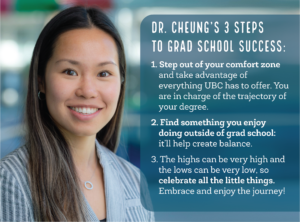
Thanks, Aaron!
After 22 years of supporting spinal cord injury research in Canada, the Aaron Moser Spinal Cord Injury Foundation has wound down its operations.
In 1998, 18-year-old junior hockey player Aaron Moser’s career abruptly ended when he was body-checked from behind into the boards during a Nanaimo Clippers game, breaking his neck and damaging his spinal cord. This spinal cord injury resulted in tetraplegia with no movement from his neck down. Aaron received an outpouring of support from his teammates, family, friends, and community which funded his rehabilitation expenses (equipment, supplies, and renovations). There were enough funds left over that Aaron was inspired to set up his own charity, the Aaron Moser Spinal Cord Injury Foundation, with the sole purpose of raising money for spinal cord research and, ultimately, to find a cure for spinal cord injuries and paralysis.
One of the clinicians on Aaron’s medical care team at Vancouver General Hospital was ICORD clinician-scientist Dr. Brian Kwon, who at the time was starting off his medical career as a resident physician. “Aaron influenced me greatly, as I was also a hockey player and to witness his injury as a resident in orthopaedic surgery and how little we could do to reverse his paralysis was very impactful. I think he had a lot to do with why I went into spine surgery and spinal cord injury research in the first place. And through the years the support from him and his foundation has provided very meaningful funding to our trainees and staff as everyone strives to push the ball forward on SCI research,” said Dr. Kwon. When Dr. Kwon received his 2021 Visionary Prize from the Craig Neilsen Foundation, he talked about his relationship with Aaron leading to a career seeking treatment for SCI in this Globe and Mail article.
For 22 years, Aaron, his parents, and volunteers ran events like golf tournaments and annual casino nights through Alberta Gaming to raise money for SCI research. The foundation made a sizable donation to ICORD in 2003 which helped to set up our Trainee Endowment. The Trainee Endowment funds our annual Aaron Moser Prize, awarded to the top poster presented by a trainee at the Doctoral level at ICORD’s Annual Research Meeting since 2006. Moser Foundation donations have also funded several important pieces of research equipment including our shared cryomicrotome, which is an instrument that can cut extremely thin sections of frozen tissue for study under a microscope, and the Granville ÄKTA Start protein purification system, which allows lab members to finish in a few hours a protocol that used to take them days.
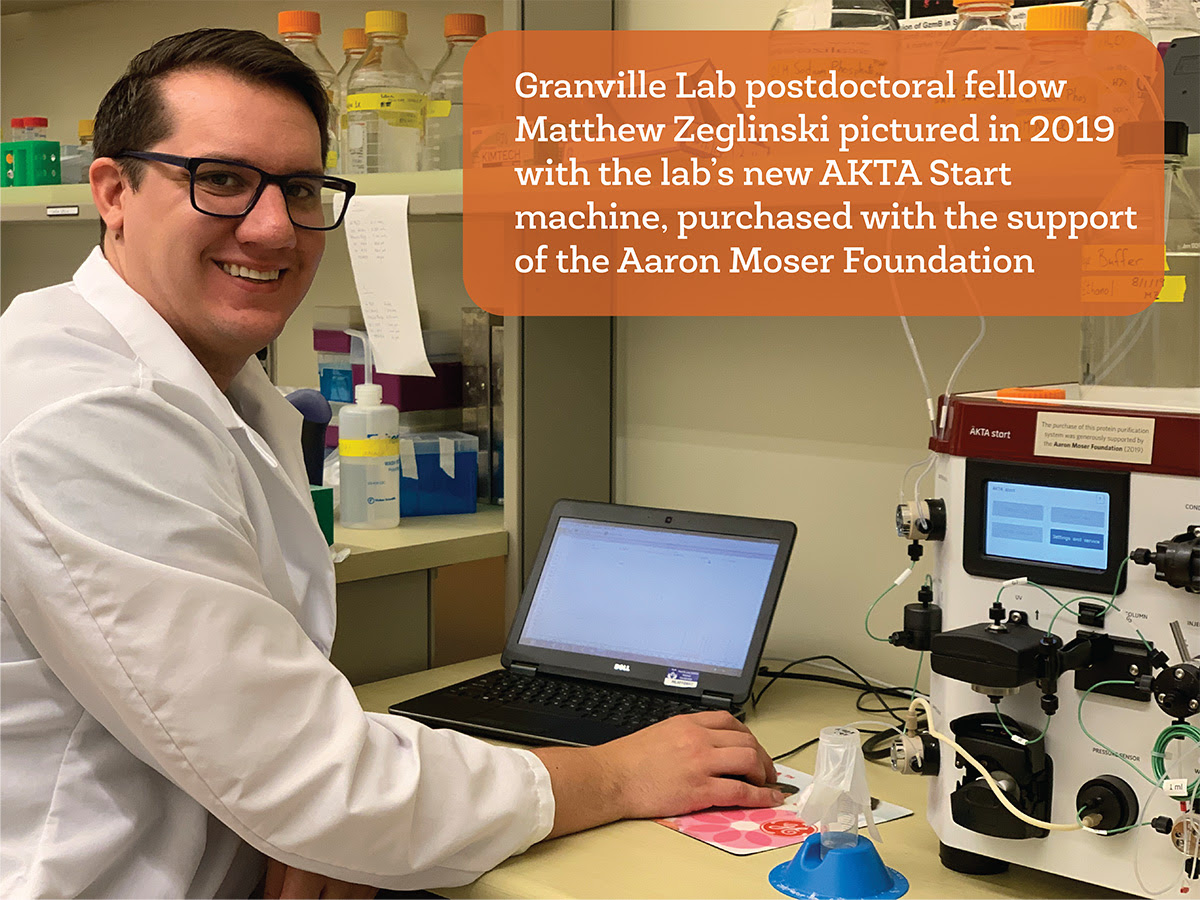
“ICORD is incredibly grateful for the generous support of the Aaron Moser Foundation since 2003,” said ICORD Director Dr. Wolfram Tetzlaff. “Aaron and his parents put a huge amount of time and energy into their foundation and have directly supported ICORD’s efforts to make spinal cord injury preventable, livable, and curable with $120,000 in donations. We will continue awarding Aaron Moser prizes at upcoming Annual Research Meetings, so even though it has wound down, the Aaron Moser Foundation will continue to have a positive effect on SCI research well into the future,” he added.

The 2022 cohort of Indigenous Summer Research Students at ICORD Vancouver. L-R Shana George (Tetzlaff Lab), Charmaine Wong (program coordinator), Dean Harris (OIBG), Carlee Leon (OIBG), Eliana Bond (Shadgan Lab). Not pictured: Iris Carr (Granville Lab).
Dean’s third year, and Carlee’s first!
ICORD’s Summer Research Program for Indigenous Youth started in the summer of 2018 as a small pilot project with one student. The program grew to three students in 2019, and then nine in 2021. This year, the program expanded to UBC-Okanagan, with great interest from ICORD labs across both campuses to host students. We were able to host a total of twelve summer students, with seven in Kelowna and five in Vancouver. We caught up with two program participants, first-timer Carlee Leon, and returning program alumnus Dean Harris, who you may recognize from last summer’s ICORDian story.

Dean (pictured, right, with two OIBG colleagues) first came to ICORD in the summer of 2019. He returned in 2021 (after a summer off because of COVID). This year was his third summer with ICORD’s Orthopaedic and Injury Biomechanics Group (OIBG), where he continued his work under the guidance of Dr. Peter Cripton. Dean conducted research on anthropometric test devices, which are more commonly known as crash test dummies. “I’m specifically doing research on crash test dummy necks. Currently I am designing a surrogate cervical disc to be used in a dummy neck,” explained Dean.
When Dean first came to ICORD as a grade 11 student, he was planning to specialize in biomedical engineering. He credits opportunities created by summer research program for exposing him to different areas of engineering research and helping him refine skills that will come in handy in his future career. “I have always liked working with technology – I started out helping with soldering and 3D printing projects at OIBG. I gained lots of experience with 3D printing, and computer-aided design, and I also gained communication, problem solving, and research skills here,” said Dean. “I originally thought I wanted to specialize in biomedical engineering, but now I’m thinking about electrical engineering instead,” he said. Dean is currently in an engineering diploma program at Capilano University, where he intends to complete one more year of studies before transferring to University of Victoria’s electrical engineering program.
With three years’ experience as a summer student, Dean stepped into a leadership role this year by helping the OIBG run a workshop for Geering Up (UBC’s STEM summer camp for kids) on vehicle safety. He also took on the role of mentoring a new summer student. Ninth-grader Carlee took part in ICORD’s summer research program for the first time this year, and worked under Dean’s supervision. “Working with Carlee was a great experience; it was a joy to supervise her. Being a supervisor for the first time gave me experience with communication skills I rarely use, like teaching and giving instructions,” said Dean.
“One thing that inspired me to apply for the Summer Research Program for Indigenous Youth is being able to experience things I might not be able to experience in school,” said Carlee. Her research involved doing statistical analyses with MATLAB (a programming platform) on data sets about movements in the sternum and head during certain types of crashes. Besides her research project, Carlee also presented her very first research poster at our summer student poster session on August 14. “It was scary at first because I didn’t know how to present, but it got easier pretty quickly,” recalls Carlee. Carlee encourages other Indigenous youths to apply to the summer program. “I would definitely recommend this program to others! My advice to anyone who’s interested in joining the program is to not be too intimidated, on top of that don’t think you’re not smart enough for the program,” advised Carlee. Her time at ICORD reinforced her interest in science. “I’m not too sure about my dream job yet but I do know that I enjoy science and I hope to do something that involves it in the future,” she said.

Dr. Cripton (shown above with Carlee and Dean) praised both students’ work this summer. “Carlee was a great student. We believe that students in different educational levels can still make really important contributions to our research as long as we don’t tell them we think they’re limited in what they can do. Somebody in Grade 9 like Carlee can learn to do quite complex analyses for us if we give them the right training and don’t stand in the way,” he said. Dr. Cripton also commented on how proud he was of Dean’s progress and Dean’s first time being a supervisor. “Dean has been amazing, and it’s been really rewarding to see how he’s gained in confidence and how he’s changed as a researcher in our group but then also how he was willing to take a leadership role with Carlee and a leadership role in his own project – much more this year than in the past. It’s great to see that and I hope and expect that this will help him in the future,” said Dr. Cripton.
For anyone or prospective students interested in learning more about the Summer Research Program for Indigenous Youth or joining us next summer, please bookmark our program site and check back early in the new year for Summer 2023 application updates.
A new collaboration with UBC-O
ICORD researcher Dr. Michael Berger is teaming up with researchers at UBC-O to examine nerve and muscle behaviour in people with SCI who still have some preserved strength below their injuries.
Dr. Berger and his research team are interested in exploring the idea that weakness and paralysis in people with SCI is caused not only by damage to the motor pathways inside the spinal cord, but also by changes that happen to nerves and muscles “downstream” of the injury. The idea that nerves and muscles besides those in the spinal cord could also be affected leads to important questions about how effective current treatments and rehabilitation may be. “We are particularly focused on how nerve and muscle damage influences outcomes from a new surgical technique called nerve transfer surgery, which has shown promise in restoring strength in previously paralyzed hand muscles,” explained Dr. Berger (see the Winter 2021 ICORDian for more on this topic).
Currently, the Berger Lab uses special techniques to explore how nerves and muscles work in humans. These techniques have not yet been investigated in people with SCI, but researchers are hoping they will be able to learn more about muscle paralysis in SCI and how this influences daily life. To further their investigation on nerve and muscle damage, the Berger Lab is collaborating with Drs. Brian Dalton and Chris McNeil at UBC-O. Drs. Dalton and McNeil are investigating the human neuromuscular system with a project examining nerve and muscle behaviour in individuals who have retained some strength below their injuries.
Dr. Berger and his colleagues hope this work will shed light on how the neuromuscular system evolves and adapts after SCI and whether these changes might influence the prognosis for recovery of muscle function.

Dr. Berger with research assistant Emmanuel Ouma.
meetICORD was an in-person success
Planned and presented by ICORD‘s Trainee Committee, our first big in-person event since March 2020 went off without a hitch on September 15. 207 people from 15 different countries gathered to hear keynote talks as well as three-minute talks by researchers and people with lived experience of SCI. Praxis, SCI BC, SCIRE, Reach BC, and several ICORD labs presented info/demonstration tables, and all the guided tours of the BSCC were fully-booked.
We are very grateful to Mesoscale Discovery (MSD), Praxis, Vancouver Coastal Health Research Institute, Dr. Brian Kwon, and the Rick Hansen Foundation for sponsoring this event.
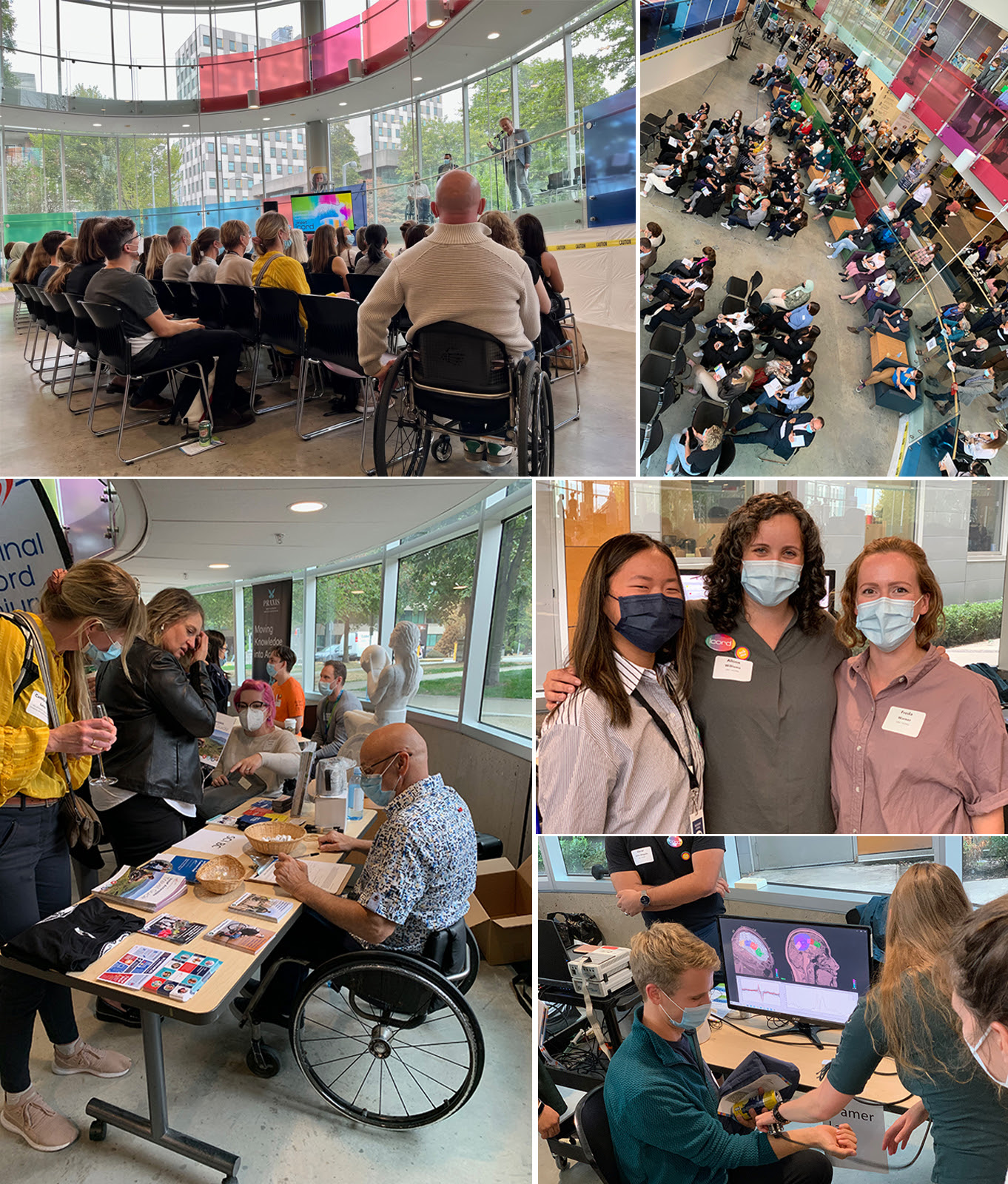
ICORD’s Annual Report for 2021-22 is now available.
Download a copy to read about our accomplishments in the past year, plus enjoy some great new lab photos by Martin Dee.
A summary of summaries
In the past few ICORDian newsletters, we highlighted several easy-to-read summaries of scientific papers by ICORD researchers (see past stories here and here). These are prepared by student volunteers at ICORD’s Community Resource Centre, who help keep our SCInfo Blog up and running with interesting summaries of published SCI research. Since the summer, we’ve added several new blog posts, including lay summaries and artwork prepared by ICORD trainee Xueqing Zhou.
- Leg cycling increases cardiorespiratory activity in tetraplegia: Preshon Pillay summarized a paper by Dr. Krassiokov and his colleagues about how exercising paralyzed legs may provide health benefits like reducing the elevated cardiovascular disease risk in people living with SCI. The study found that cardiovascular function was increased during passive leg cycling.
 Oxygen uptake during adapted rowing versus arm cycle: Xueqing Zhou summarized research by Drs. Sawatzky, Mortenson, Borisoff, and Sparrey. This study compared oxygen uptake during use of the adapted rowing machine and the arm cycle. They found that at the same workload, participants reached a much higher oxygen intake using the adapted rowing machine, showing the benefits of aerobic exercise.
Oxygen uptake during adapted rowing versus arm cycle: Xueqing Zhou summarized research by Drs. Sawatzky, Mortenson, Borisoff, and Sparrey. This study compared oxygen uptake during use of the adapted rowing machine and the arm cycle. They found that at the same workload, participants reached a much higher oxygen intake using the adapted rowing machine, showing the benefits of aerobic exercise.
Thank you to our Resource Centre volunteers for our SCInfo Blog up to date with new SCI research findings. There are blog posts being uploaded on a regular basis so be sure to bookmark the SCInfo site to see what’s new.
Meet our newest members!

The SCI Action Canada Lab and the Applied Behaviour Change (ABC) Lab, led by Kathleen Martin Ginis and Heather Gainforth, is excited to welcome five new ICORD-O members and trainees:
Kenedy Olsen is a research coordinator in the SCI Action Canada Lab. She coordinates a number of studies, with her main focus on the EPIC-SCI trial. This ongoing study is evaluating the effects of following the International SCI Exercise Guidelines over the course of a 6-month period, as well as the relationship between exercise and chronic pain among individuals living with SCI.
Nate Adams‘s research characterizes the physiological mechanisms and psychosocial outcomes during acute bouts of sedentary behaviour in people with SCI. This research aims to determine if promotion of intermittent light physical activity may be beneficial for cardiometabolic health.
Robert Buren is a PhD student in SCI Action Canada Lab. Robert’s primary research will investigate the potential of mindfulness meditation for pain relief to reduce neuropathic pain among individuals with a spinal cord injury.
Maji Shaikh is a post-doctoral fellow whose area of research is positive youth development in community programming. He is working with Dr. Heather Gainforth to explore how researchers and community sport and recreation organizations can meaningfully partner to create holistic environments for youth’s development.
Matteo Ponzano is a physical activity and health promotion scientist in the SCI Action Canada Lab. His research focuses on the development and implementation of non-pharmacological interventions to address three main three main research priorities in people with physical disabilities: 1) improving mental health and quality of life; 2) promoting adoption and maintenance of healthy behaviours; and 3) preventing falls and fractures.
Art under the microscope
Sometimes you just have to appreciate the beauty
by Oscar Seira
These are images of astrocytes growing on a petri dish. They have been stained using GFAP, which is a marker for astrocytes (violet) and DAPI, which is a cell nuclei marker (blue). They’re not showing anything new or exciting, but the images are so beautiful they needed to be shared.


New Study Liaison is here to help!
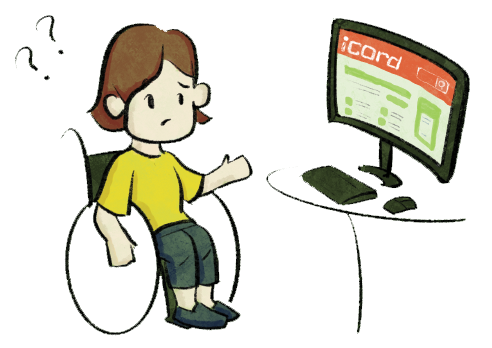 Interested in participating in ICORD research but feeling overwhelmed by the number of studies? Meet our new study liaison, Nicole Bailey!
Interested in participating in ICORD research but feeling overwhelmed by the number of studies? Meet our new study liaison, Nicole Bailey!
Nicole is currently an MSc student in the Kramer lab, as well as a Co-Chair for the ICORD Trainee Committee.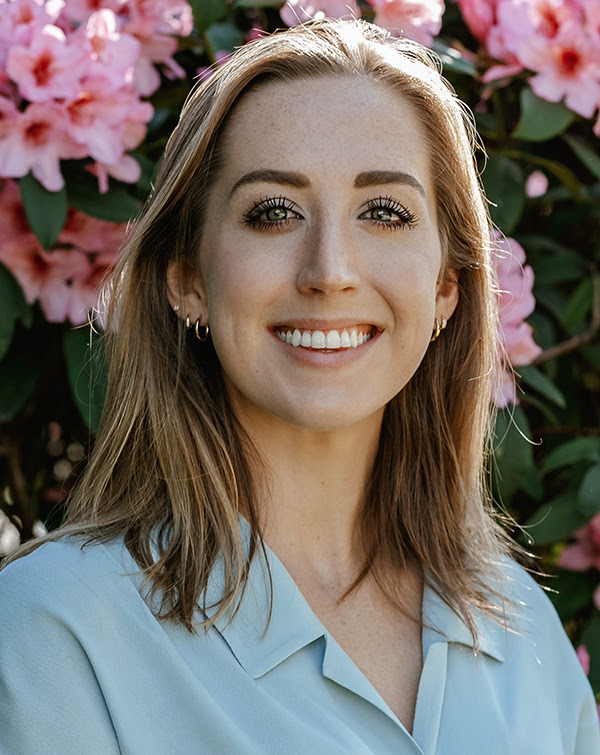
As a study liaison, Nicole will work with you to narrow down what studies you may be eligible for. Over a few short phone calls, she will ask you questions about your research interests as well as common study inclusion and exclusion criteria. From there she will tailor a list of research studies for you and provide details and contact information for each one. She can also directly connect you with study coordinators if you like. Send her an email to begin your consultation!
Help us do research
Interested in helping ICORD researchers make SCI preventable, livable, and curable? These research studies (and more) are in need of participants!
Exercise guidelines Promotion and Implementation in Chronic Spinal Cord Injury
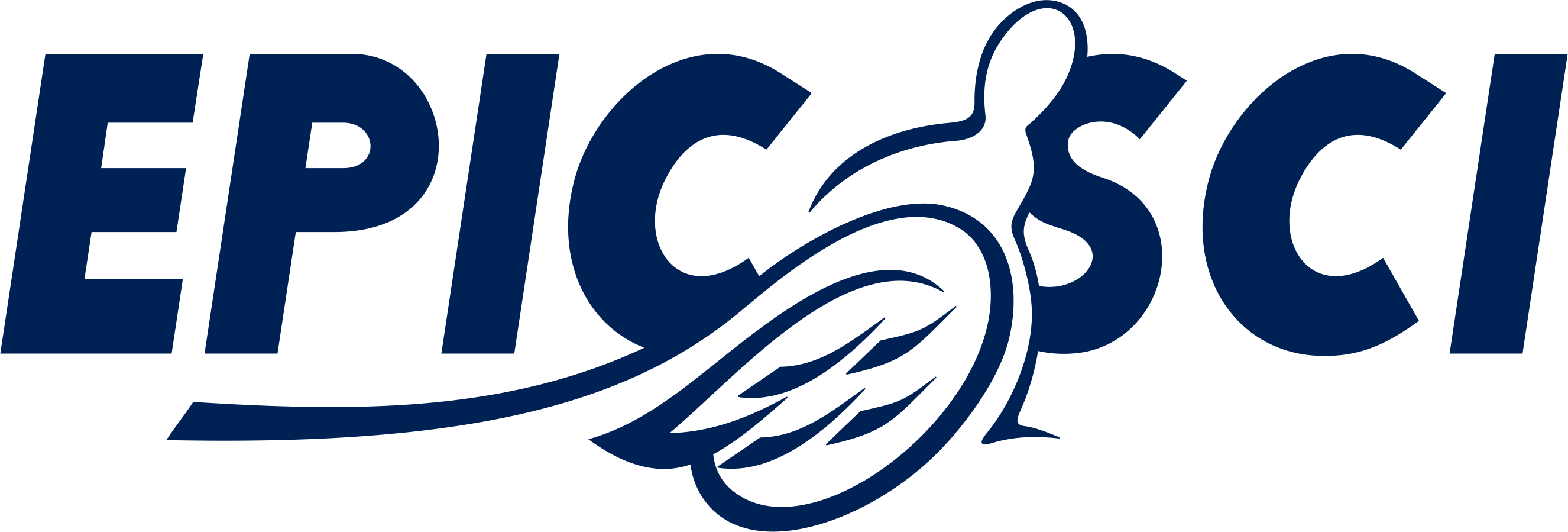 Dr. Kathleen Martin Ginis is interested in evaluating the effects of following the International SCI Exercise Guidelines over the course of a 6-month period. Participants who volunteer for this study will be randomly allocated to one of two groups. One of the groups will follow an exercise program for 6 months. The other group (i.e. control group) will be asked not to change their daily lifestyle for 6 months. After this, the control group will have the opportunity to enjoy the 6-month exercise program. A personal trainer and the participant will set up the exercise program together.
Dr. Kathleen Martin Ginis is interested in evaluating the effects of following the International SCI Exercise Guidelines over the course of a 6-month period. Participants who volunteer for this study will be randomly allocated to one of two groups. One of the groups will follow an exercise program for 6 months. The other group (i.e. control group) will be asked not to change their daily lifestyle for 6 months. After this, the control group will have the opportunity to enjoy the 6-month exercise program. A personal trainer and the participant will set up the exercise program together.
Burden of Intermittent Catheterization

Researchers in Dr. Andrei Krassioukov’s lab are interested in exploring the effect of intermittent catheterization in the health of individuals with SCI, specifically in regards to the presence of urinary tract infections (UTIs) and episodes of autonomic dysreflexia (AD). The primary purpose of this part of the study will be looking at the impact of re-using catheters of intermittent catheterization on the rate of UTIs and urinary bacterial levels.
Barriers & Facilitators to Bowel Care Management After Spinal Cord Injury

Researchers in the Claydon lab are inviting you to participate in a phone interview about making changes to bowel care after SCI. They are currently recruiting medical professionals to discuss bowel care routines and what makes changing them difficult. The purpose of this study is to investigate what helps and what hinders individuals in deciding to make changes to their bowel care routines. Participants will fill out an online screening tool that will determine eligibility followed by talking with one of the researchers about your thoughts on bowel care.
Using Near Infrared Spectroscopy (NIRS) on pelvic floor muscles
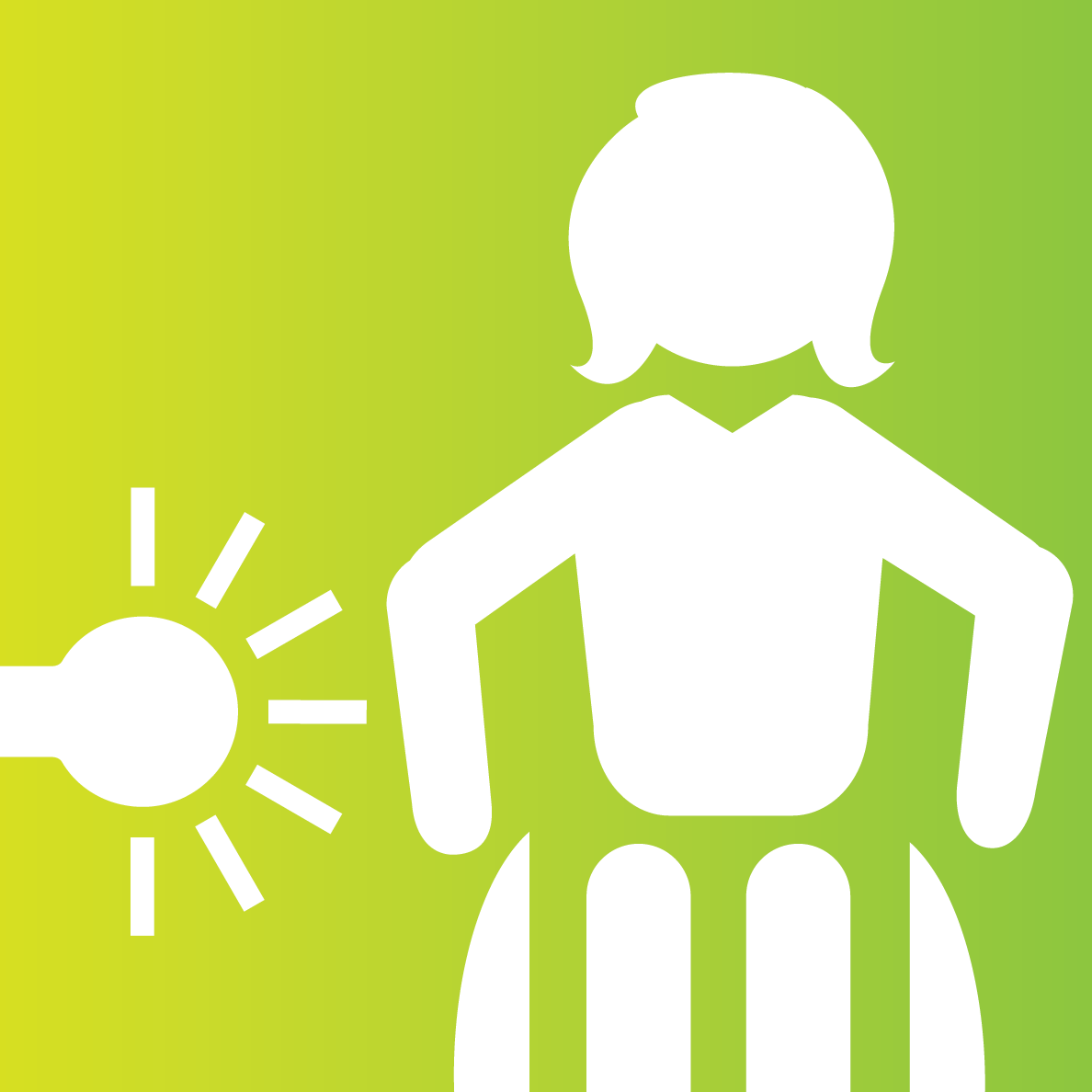 Researchers in the lab of Dr. Lynn Stothers are studying a device that uses light to determine the fitness of muscles in the body. Specifically, the researchers want to look at the pelvic floor muscles that help with bladder control. This study will measure the difference in the amount of oxygen delivered to the pelvic floor muscle fibres using NIRS. The study will look at whether exercise makes any difference in the amount of oxygen in muscle fibres of the pelvic floor by comparing women who are continent (do not have a problem with bladder control and do not have neurogenic disease) with incontinent women (do have problems with bladder control and have neurogenic disease).
Researchers in the lab of Dr. Lynn Stothers are studying a device that uses light to determine the fitness of muscles in the body. Specifically, the researchers want to look at the pelvic floor muscles that help with bladder control. This study will measure the difference in the amount of oxygen delivered to the pelvic floor muscle fibres using NIRS. The study will look at whether exercise makes any difference in the amount of oxygen in muscle fibres of the pelvic floor by comparing women who are continent (do not have a problem with bladder control and do not have neurogenic disease) with incontinent women (do have problems with bladder control and have neurogenic disease).
Cycling Infrastructure Project

Researchers in Dr. Ben Mortenson’s lab are interested in the transportation and cycle lane experiences of cyclists or wheeled mobility device users (e.g. users of manual or power wheelchairs, wheeled mobility scooters).
FashionABLE: Adaptive fashion guide for the people, by the people with SCI

Researchers in Dr. Krassioukov’s lab are inviting people with SCI and health care professionals involved in the care of individuals with SCI to share their current perspectives and practices related to adaptive clothing.

Researchers in Dr. Kathleen Martin Ginis’s lab are focussing on promoting and implementing physical activity guidelines for adults with disabilities. Their study purposes are to look at participation within a community-based exercise program for adults with disabilities and to better understand the experiences and perceptions of individuals participating in an exercise program for adults with disabilities.
Effects of a new method of exercise (LI-BFR) on skeletal muscle development in people with SCI

Researchers in Dr. Babak Shadgan’s lab want to determine if a new method for exercising forearm muscle that involves several rounds of low-intensity (LI) exercise while applying blood flow restriction (BFR) using a tourniquet over the arm, is a more effective methodology for increasing muscular strength and size over an eight-week training period.
Sex differences in cardiac function in individuals high-level SCI
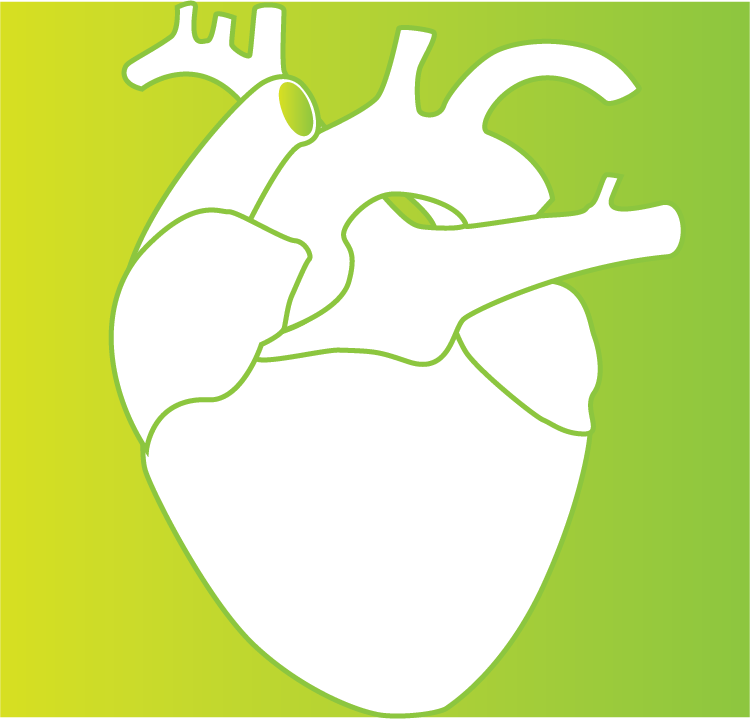 Drs. Chris West and Alex Williams are investigating whether there are differences between the male and female heart in individuals with spinal cord injuries (SCI) between the C4 and T6 levels, in comparison to any sex-related differences that exist in uninjured individuals. They want to know whether these sex-related differences in the heart exist at rest, and also when your posture changes.
Drs. Chris West and Alex Williams are investigating whether there are differences between the male and female heart in individuals with spinal cord injuries (SCI) between the C4 and T6 levels, in comparison to any sex-related differences that exist in uninjured individuals. They want to know whether these sex-related differences in the heart exist at rest, and also when your posture changes.
Click here to browse all the ICORD studies currently recruiting participants.
Partner news
 Four new chapters have been published recently on SCIRE Professional in collaboration with two world experts in SCI – Dr. Kathleen Martin Ginis of UBC Okanagan (Physical Activity) and Dr. MJ Mulcahey of Thomas Jefferson University (Pediatrics).
Four new chapters have been published recently on SCIRE Professional in collaboration with two world experts in SCI – Dr. Kathleen Martin Ginis of UBC Okanagan (Physical Activity) and Dr. MJ Mulcahey of Thomas Jefferson University (Pediatrics).
- Physical Activity: Cardiovascular Health and Exercise – this chapter reviews the effect that various forms of exercise have on cardiovascular and metabolic function in people with chronic SCI.

- Physical Activity: Participation – this review answers the question – What interventions and tools can help people with SCI increase their participation in Physical Activity?
- Pediatric SCI: Epidemiology – Though comparatively rare, a small percentage of SCI occurs in children, with some slightly higher rates that are due to congenital or genetic causes. This chapter looks at the incidence and prevalence of pediatric SCI across the globe.
- Pediatric SCI – Rehabilitation – The growth and development that takes place during childhood and adolescence changes the rehabilitation necessary in kids with SCI – this review details the evidence for interventions specific to pediatric SCI.
Partner news
 Our annual report is now available online!
Our annual report is now available online!
This year’s annual report focuses on resilience — a fitting theme that showcases our most impactful achievements during the ongoing COVID-19 pandemic.
Click here to read the report.
Accessibility and disability inclusion education
The Rick Hansen Foundation has collaborated with people with physical disabilities, experts in the built environment, legislation and building code as well as accessibility professionals and education partners to create training courses and resources on accessibility and disability awareness.
If you are a Canadian with a disability or a resident of BC or Ontario who is interested in learning more about accessibility and disability awareness, you could be eligible for a tuition subsidy. Learn more at www.RickHansen.com/Courses
Discovery to Commercialization: Exploring pathways to transition into industry careers
November 30, 2-5:30pm
St. Regis Hotel, 608 Dunsmuir Street
Join us for an informative session and networking social focused on pathways to transition into industry careers. Join the speed mentoring sessions to make effective career choices in industry, and meet with health professionals and industry partners who are dedicated to furthering the commercialization and business development of health research. Learn more and register here.
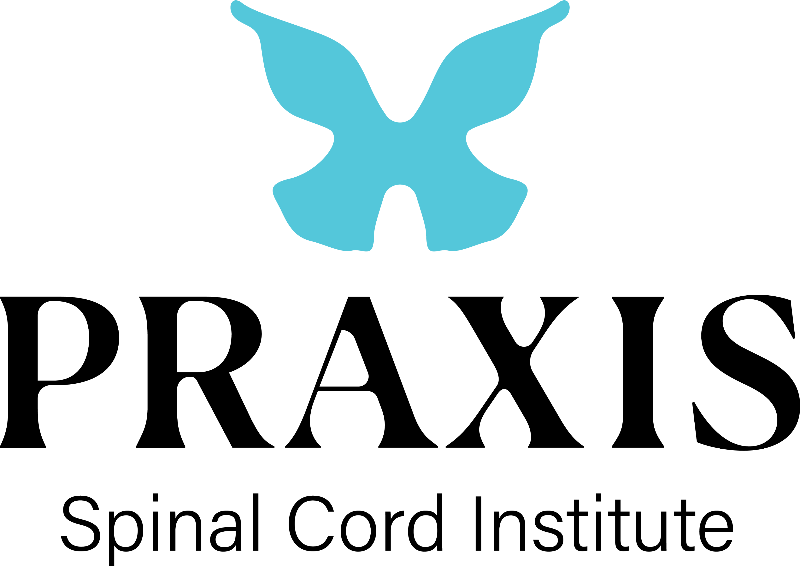 Richard Peter, Praxis Indigenous Peoples Liaison, is currently involved as a member of the Vancouver 2030 Olympic bid committee, acting as Paralympic athlete ambassador. Learn more.
Richard Peter, Praxis Indigenous Peoples Liaison, is currently involved as a member of the Vancouver 2030 Olympic bid committee, acting as Paralympic athlete ambassador. Learn more.
Learning Circles newsletters have continued each month since June. Activating the National SCI Care Strategy, each issue covers a different expert or theme, seeking to inspire, inform and incentivize the SCI community with regard to best practices in care and management. Learn more.
John Chernesky, Consumer Engagement Program Manager, featured in a recent Science News article, bringing a lived perspective to spinal cord stimulation as therapy. Learn more.
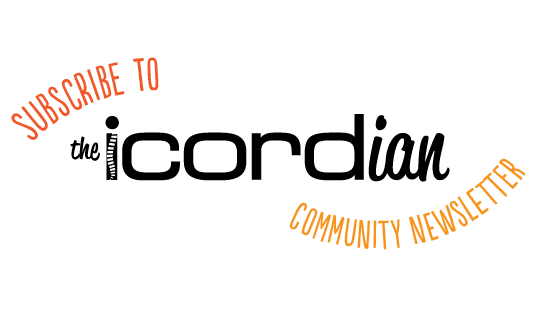 Thanks for reading this issue of The ICORDian – we hope you enjoyed it! Please subscribe and have future issues delivered to your inbox. If you have any comments about this issue or suggestions for future ones, please contact us.
Thanks for reading this issue of The ICORDian – we hope you enjoyed it! Please subscribe and have future issues delivered to your inbox. If you have any comments about this issue or suggestions for future ones, please contact us.
|
Jocelyn Chan, Femke Hoekstra, Dean Harris, Carlee Leon, Amanda Cheung, Peter
Cripton, Mike Berger, Oscar Seira, Matthew Queree, and Nancy Thorogood for their contributions to this issue of our newsletter.
|






